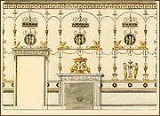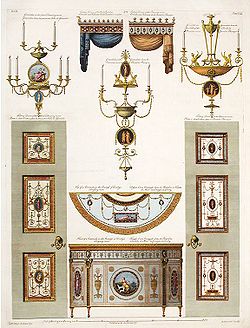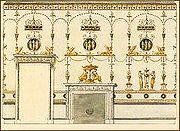
Adam style
Encyclopedia

Neoclassicism
Neoclassicism is the name given to Western movements in the decorative and visual arts, literature, theatre, music, and architecture that draw inspiration from the "classical" art and culture of Ancient Greece or Ancient Rome...
style of interior design
Interior design
Interior design describes a group of various yet related projects that involve turning an interior space into an effective setting for the range of human activities are to take place there. An interior designer is someone who conducts such projects...
and architecture
Architecture
Architecture is both the process and product of planning, designing and construction. Architectural works, in the material form of buildings, are often perceived as cultural and political symbols and as works of art...
, as practiced by the three Adam brothers from Scotland
Scotland
Scotland is a country that is part of the United Kingdom. Occupying the northern third of the island of Great Britain, it shares a border with England to the south and is bounded by the North Sea to the east, the Atlantic Ocean to the north and west, and the North Channel and Irish Sea to the...
; of whom Robert Adam
Robert Adam
Robert Adam was a Scottish neoclassical architect, interior designer and furniture designer. He was the son of William Adam , Scotland's foremost architect of the time, and trained under him...
(1728–1792) and James Adam (1732–1794) were the most widely known.
The Adam brothers were the first to advocate an integrated style for architecture and interiors; with walls, ceilings, fireplaces, furniture, fixtures, fittings and carpets all being designed by the Adams as a single uniform scheme. Commonly and mistakenly known as "Adams Style," the proper term for this style of architecture and furniture is the "Style of the Brothers Adam."
The Adam style found its niche from the late 1760s in upper-class and middle-class residences in 18th-century England
England
England is a country that is part of the United Kingdom. It shares land borders with Scotland to the north and Wales to the west; the Irish Sea is to the north west, the Celtic Sea to the south west, with the North Sea to the east and the English Channel to the south separating it from continental...
, Scotland
Scotland
Scotland is a country that is part of the United Kingdom. Occupying the northern third of the island of Great Britain, it shares a border with England to the south and is bounded by the North Sea to the east, the Atlantic Ocean to the north and west, and the North Channel and Irish Sea to the...
, Russia
Russia
Russia or , officially known as both Russia and the Russian Federation , is a country in northern Eurasia. It is a federal semi-presidential republic, comprising 83 federal subjects...
(where it was introduced by Scottish architect Charles Cameron
Charles Cameron (architect)
Charles Cameron was a Scottish architect who made an illustrious career at the court of Catherine II of Russia. Cameron, practitioner of early neoclassical architecture, was the chief architect of Tsarskoye Selo and Pavlovsk palaces and the adjacent new town of Sophia from his arrival in Russia in...
), and post-Revolutionary War
American Revolutionary War
The American Revolutionary War , the American War of Independence, or simply the Revolutionary War, began as a war between the Kingdom of Great Britain and thirteen British colonies in North America, and ended in a global war between several European great powers.The war was the result of the...
United States
United States
The United States of America is a federal constitutional republic comprising fifty states and a federal district...
(where it became known as Federal style and took on a variation of its own). The style was superseded from around 1795 onwards by the Regency style and the French Empire style.
Building Boom
During the 18th century there was much work for eager architects and designers, as Britain experienced a boom in the building of new houses, theatres, shops, offices and factories, with towns growing rapidly due to the onset of the Industrial RevolutionIndustrial Revolution
The Industrial Revolution was a period from the 18th to the 19th century where major changes in agriculture, manufacturing, mining, transportation, and technology had a profound effect on the social, economic and cultural conditions of the times...
. The emphasis was on modernisation, with regulations being introduced to clean up the nation’s streets, promoting the re-paving of roads and pavements, improving drainage and street lighting, and better fireproofing of buildings with the widespread use of brick and stone.
Speculative building was rife, with some developers focussing on high speed and low cost. Sometimes, newly built houses collapsed due to poor workmanship; whilst others continually shifted on their foundations, giving rise to the phrase "things that go bump in the night", as mysterious crashes, creaks and thuds were heard by their inhabitants late at night.
London
History of London
London, the capital of the United Kingdom , has a recorded history that goes back over 2,000 years. During this time, it has grown to become one of the most significant financial and cultural capitals of the world. It has experienced plague, devastating fire, civil war, aerial bombardment and...
experienced major expansion, with the newly build West End, which included the elegant squares of Mayfair
Mayfair
Mayfair is an area of central London, within the City of Westminster.-History:Mayfair is named after the annual fortnight-long May Fair that took place on the site that is Shepherd Market today...
; areas of the East End of London were also developed, such as the new terraces in Spitalfields
Spitalfields
Spitalfields is a former parish in the borough of Tower Hamlets, in the East End of London, near to Liverpool Street station and Brick Lane. The area straddles Commercial Street and is home to many markets, including the historic Old Spitalfields Market, founded in the 17th century, Sunday...
. The cities of Edinburgh
Edinburgh
Edinburgh is the capital city of Scotland, the second largest city in Scotland, and the eighth most populous in the United Kingdom. The City of Edinburgh Council governs one of Scotland's 32 local government council areas. The council area includes urban Edinburgh and a rural area...
, Bristol
History of Bristol
Bristol is a city with a population of nearly half a million people in south west England, situated between Somerset and Gloucestershire on the tidal River Avon. It has been amongst the country's largest and most economically and culturally important cities for eight centuries. The Bristol area...
and Dublin
History of Dublin
The City of Dublin can trace its origin back more than 1,000 years, and for much of this time it has been Ireland's principal city and the cultural, educational and industrial centre of the island.-Founding and early history:...
were all expanded and modernised. Birmingham
History of Birmingham
The history of Birmingham in England spans 1400 years of growth, during which time it has evolved from a small 7th century Anglo Saxon hamlet on the edge of the Forest of Arden at the fringe of early Mercia to become a major city through a combination of immigration, innovation and civic pride that...
was described in 1791 as being the "first manufacturing town in the world". Manchester
History of Manchester
The history of Manchester encompasses its change from a minor Lancastrian township into the pre-eminent industrial metropolis of the United Kingdom and the world. Manchester began expanding "at an astonishing rate" around the turn of the 19th century as part of a process of unplanned urbanisation...
and Liverpool
History of Liverpool
The history of Liverpool can be traced back to 1190 when the place was known as 'Liuerpul', possibly meaning a pool or creek with muddy water. Other origins of the name have been suggested, including 'elverpool', a reference to the large number of eels in the Mersey, but the definitive origin is...
each saw their population treble between 1760 and 1800. New towns, like Bath, were constructed around natural spas. Old medieval cities and market towns, such as York
History of York
The history of York as a city dates to the beginning of the first millennium AD but archaeological evidence for the presence of people in the region of York date back much further to between 8000 and 7000 BC...
and Chichester
Chichester
Chichester is a cathedral city in West Sussex, within the historic County of Sussex, South-East England. It has a long history as a settlement; its Roman past and its subsequent importance in Anglo-Saxon times are only its beginnings...
, had their buildings re-fronted with brick or stucco, plus new sash windows, to give the impression of modernity, despite the underlying structures remaining medieval.
Pattern Books & Style Guides
The neo-classical style was all the vogue throughout the 18th century, and many style guides were published to advise builders how their finished properties should look. Influential guides included Stephen Riou's The Grecian Orders (1768), and Batty LangleyBatty Langley
Batty Langley was an English garden designer, and prolific writer who produced a number of engraved designs for "Gothick" structures, summerhouses and garden seats in the years before the mid-18th century.The eccentric landscape designer, who gave some of his numerous children names like Hiram,...
's A Sure Guide to Builders (1729), The Young Builder's Rudiments (1730 and 1734), Ancient Masonry (1736), The City and Country Builder's and Workman's Treasury of Designs (1740 and later editions), The Builder's Jewel (1741). Architects, designers, cabinet makers, stonemasons and craftsmen all publishing pattern books and style guides to advertise their ideas, thereby hoping to attract a lucrative clientele.
The Adam Style
The work of the Adam brothers set the style for domestic architecture and interiors for much of the latter half of the 18th century.Robert and James Adam travelled in Italy and Dalmatia in the 1750s, observing the ruins of the classical world. On their return to Britain, they set themselves up with their older brother, John
John Adam (architect)
John Adam was a Scottish architect. Born in Linktown of Abbotshall, now part of Kirkcaldy, Fife, he was the eldest son of architect and entrepreneur William Adam. His younger brothers Robert and James Adam also became architects.The Adam family moved to Edinburgh in 1728, as William Adam's career...
, as architects. Robert and James published a book entitled The Works in Architecture in instalments between 1773 and 1779. This book of engraved designs made the Adam repertory available throughout Europe. The Adam brothers aimed to simplify the rococo
Rococo
Rococo , also referred to as "Late Baroque", is an 18th-century style which developed as Baroque artists gave up their symmetry and became increasingly ornate, florid, and playful...
and baroque
Baroque
The Baroque is a period and the style that used exaggerated motion and clear, easily interpreted detail to produce drama, tension, exuberance, and grandeur in sculpture, painting, literature, dance, and music...
styles which had been fashionable in the preceding decades, to bring what they felt to be a lighter and more elegant feel to Georgian houses. The Works in Architecture illustrated the main buildings the Adam brothers had worked on and crucially documented the interiors, furniture and fittings, designed by the Adams.
A parallel development of this phase of neoclassical design is the French Louis XVI style.
The Adam style moved away from the strict mathematical proportions previously found in Georgian rooms, and introduced curved walls and domes, decorated with elaborate plasterwork and striking mixed colour schemes using newly affordable paints in pea green, sky blue, lemon, lilac, bright pink, and red-brown terracotta.
Artists such as Angelica Kauffmann
Angelica Kauffmann
Maria Anna Angelika/Angelica Katharina Kauffman was a Swiss-Austrian Neoclassical painter. Kauffman is the preferred spelling of her name; it is the form she herself used most in signing her correspondence, documents and paintings.- Early years :She was born at Chur in Graubünden, Switzerland,...
and Antonio Zucchi
Antonio Zucchi
Antonio Zucchi was an Italian painter of the Neoclassic period. Born in Venice and died in Rome. He married the painter Angelica Kauffmann, who late in life, moved with him to Rome. He produced a number of etchings of capriccio and veduta of classical buildings or ruins. He worked with Robert Adam...
were employed to paint classical figurative scenes within cartouches set into the interior walls and ceilings.
The Adam's main rivals were James Wyatt
James Wyatt
James Wyatt RA , was an English architect, a rival of Robert Adam in the neoclassical style, who far outdid Adam in his work in the neo-Gothic style.-Early classical career:...
, whose many designs for furniture were less known outside the wide circle of his patrons, because he never published a book of engravings; and Sir William Chambers
William Chambers (architect)
Sir William Chambers was a Scottish architect, born in Gothenburg, Sweden, where his father was a merchant. Between 1740 and 1749 he was employed by the Swedish East India Company making several voyages to China where he studied Chinese architecture and decoration.Returning to Europe, he studied...
, who designed fewer furnishings for his interiors, preferring to work with such able cabinet-makers as John Linnell, Thomas Chippendale
Thomas Chippendale
Thomas Chippendale was a London cabinet-maker and furniture designer in the mid-Georgian, English Rococo, and Neoclassical styles. In 1754 he published a book of his designs, titled The Gentleman and Cabinet Maker's Director...
, and Ince and Mayhew
Ince and Mayhew
Ince and Mayhew were a partnership of furniture designers, upholsterers and cabinetmakers, founded and run by William Ince and John Mayhew in London, England, from 1759 to 1803; Mayhew continued alone in business until 1809. Their premises were listed in London directories in Broad Street, Soho,...
. So many able designers were working in this style in London from circa 1770 that the style is currently more usually termed Early Neoclassical.

The Adam style is identified with:
- Classical RomanRoman architectureAncient Roman architecture adopted certain aspects of Ancient Greek architecture, creating a new architectural style. The Romans were indebted to their Etruscan neighbors and forefathers who supplied them with a wealth of knowledge essential for future architectural solutions, such as hydraulics...
decorative motifs, such as framed medallions, vases, urns and tripods, arabesqueArabesqueThe arabesque is a form of artistic decoration consisting of "surface decorations based on rhythmic linear patterns of scrolling and interlacing foliage, tendrils" or plain lines, often combined with other elements...
vine scrolls, sphinxSphinxA sphinx is a mythical creature with a lion's body and a human head or a cat head.The sphinx, in Greek tradition, has the haunches of a lion, the wings of a great bird, and the face of a woman. She is mythicised as treacherous and merciless...
es, griffinGriffinThe griffin, griffon, or gryphon is a legendary creature with the body of a lion and the head and wings of an eagle...
s, and dancing nymphs - Flat grotesque panels
- Pilasters
- Painted ornaments, such as swags and ribbons
- Complex pastel colour schemes
The Adam style was superseded from around 1795 onwards by the simpler Regency style in Britain; and the French Empire style in France and Russia, which was a more imperial and self-consciously archeological style, connected with the First French Empire
First French Empire
The First French Empire , also known as the Greater French Empire or Napoleonic Empire, was the empire of Napoleon I of France...
.
Influenced by
The Adam Style was strongly influenced by:- Frescoes and wall paintings found in the newly excavated Roman cities of PompeiiPompeiiThe city of Pompeii is a partially buried Roman town-city near modern Naples in the Italian region of Campania, in the territory of the comune of Pompei. Along with Herculaneum, Pompeii was destroyed and completely buried during a long catastrophic eruption of the volcano Mount Vesuvius spanning...
and HerculaneumHerculaneumHerculaneum was an ancient Roman town destroyed by volcanic pyroclastic flows in AD 79, located in the territory of the current commune of Ercolano, in the Italian region of Campania in the shadow of Mt... - Etruscan Greek black and red vases, which were being excavated and collected in large numbers
- Classical Greek architecture, which was known in Britain through publications such as James Stuart & Nicholas Revett's book The Antiquities of Athens published in 1762.
Revival
Interest in the Adam style was revived in the late VictorianVictorian era
The Victorian era of British history was the period of Queen Victoria's reign from 20 June 1837 until her death on 22 January 1901. It was a long period of peace, prosperity, refined sensibilities and national self-confidence...
and Edwardian eras, initiated by a spectacular marquetry cabinet by Wright & Mansfield exhibited at the Paris Exposition of 1867. Reproduction furniture in the general "Regency Revival" style, to which the Adam revival was closely linked, was very popular with the expanding middle classes from circa 1880 to 1920. They were attracted to the light and elegant designs, as a contrast to the heavier and more cluttered interiors which had dominated their homes during the second half of the 19th century. The revival competed with the Arts and Crafts
Arts and Crafts movement
Arts and Crafts was an international design philosophy that originated in England and flourished between 1860 and 1910 , continuing its influence until the 1930s...
style, which continued to be popular in Britain up to the 1930s. The Adam and Regency revivals, however, lost mainstream momentum after World War I
World War I
World War I , which was predominantly called the World War or the Great War from its occurrence until 1939, and the First World War or World War I thereafter, was a major war centred in Europe that began on 28 July 1914 and lasted until 11 November 1918...
, being replaced by Art Deco
Art Deco
Art deco , or deco, is an eclectic artistic and design style that began in Paris in the 1920s and flourished internationally throughout the 1930s, into the World War II era. The style influenced all areas of design, including architecture and interior design, industrial design, fashion and...
in popular taste.

